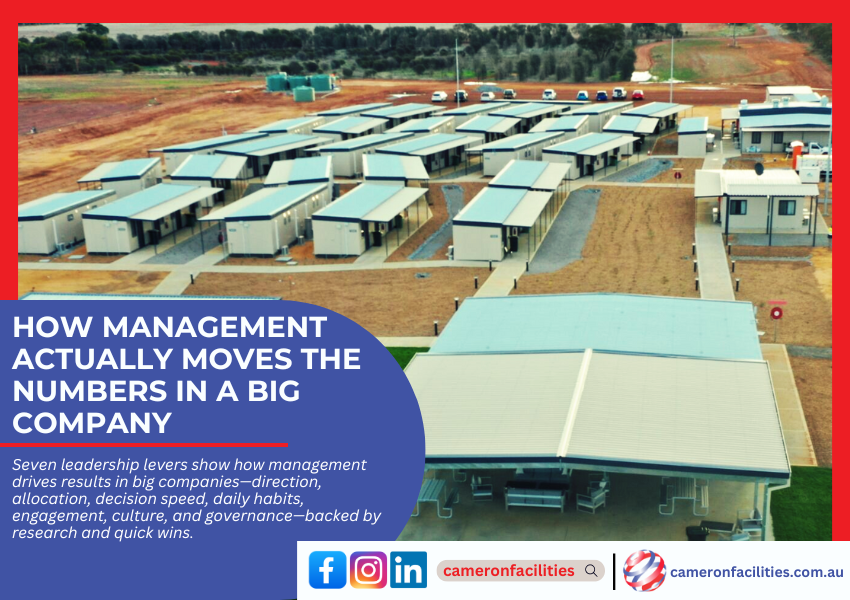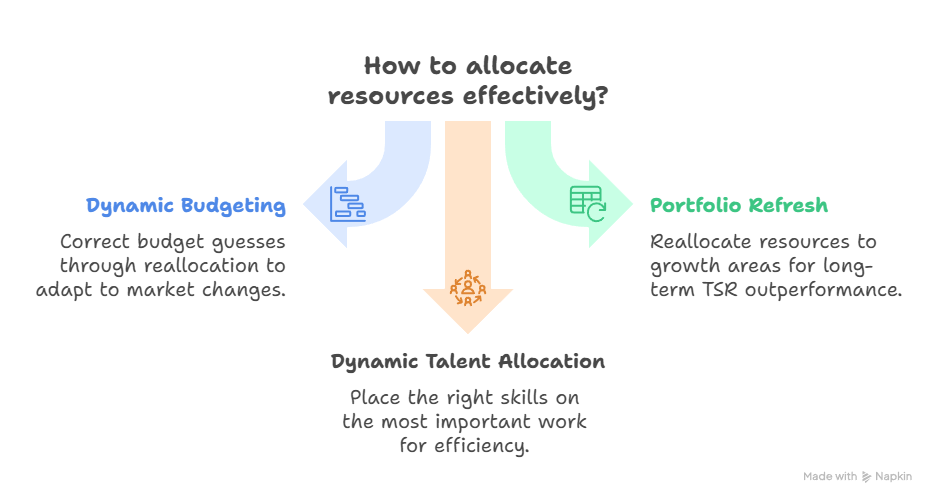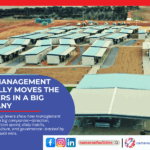
Management shapes results through seven levers: direction, allocation, decision speed, daily practices, people engagement, culture, and governance. Use them well, and performance follows.
How does management influence a business? In large companies, the impact shows up in growth, profit, and resilience. Not by chance, but by design. Healthy organizations are more likely to outperform over time, and the data backs it up (see McKinsey’s Organizational Health Index and this research on why organizational health drives long‑term performance).
“If your management system doesn’t turn strategy into action, it turns into noise.”
This guide shows how management moves the numbers in big corporations and what to do next.
1) Set direction that turns into action
Strategy only matters when it reaches the front line. Great managers make the big goals simple. They translate them into a few metrics and clear ownership.
“If people can’t see how their work moves a company metric, they stop trying.”
Strong, well‑aligned companies execute better and renew faster, which is why organizational health is a leading indicator of performance (see how OHI works and why it’s a predictor of sustained results).
Try this now: Pick three enterprise metrics that matter this year. Tie each to an accountable leader. Review progress monthly.
2) Allocate capital and talent dynamically (not just annually)
Budgets are guesses. Markets move. Winners reallocate.
“Budgets are guesses; reallocation is how you correct them.”
Long‑term TSR outperformers refresh their portfolio and shift resources to growth more often than peers (see McKinsey’s paths to TSR outperformance and guidance on tying short‑term decisions to long‑term strategy). Leading firms also move people faster, dynamic talent allocation puts the right skills on the most important work (example and playbook).
Try this now: Run a quarterly resource review. Shift at least 5% of spending and top talent to the best opportunities. Kill or pause low‑return bets.
3) Design decision rights for speed
Slow decisions are expensive decisions. Clarify who decides, who advises, and how fast.
“Clarity beats consensus when the clock is ticking.”
Enterprise agility improves customer outcomes and efficiency when decision rights move closer to the work (see research on enterprise agility and impact, plus field evidence on shaping for agility). Practical tip: define the accountable decider and push authority to the edge (decision‑making guide).
Try this now: For your top 10 cross‑functional decisions, write one line each: “X decides by Y date, informed by A/B/C.”
4) Run disciplined management practices every day
The boring stuff works. Planning cadences. Performance dialogues. Continuous improvement. Standard work where it helps.
“Excellence is just good habits you keep on boring days.”
Across thousands of firms, better management practices link to higher productivity, profitability, and survival (World Management Survey evidence; executive overview from HBS on management practices across countries). National statistics show wide dispersion by firm and sector—meaning there’s room to improve (see the UK’s official review of management practices 2016–2023 and full bulletin PDF).
Try this now: Hold a monthly performance review that fits on one page: targets, trends, owner, next action.
5) Engage your people to unlock performance
People do their best for managers who see them and coach them. Engagement isn’t “soft.” It is a lever.
“People don’t give their best to a spreadsheet. They give it to a manager who notices.”
Meta‑analyses link higher engagement to better productivity, profitability, retention, safety, and customer ratings (see Gallup’s engagement–outcomes meta‑analysis and complementary summaries of global workplace findings).
Try this now: Ask every manager to hold one purposeful 15‑minute conversation per week with each direct report: goals, progress, one blocker.
6) Build a culture that scales (organizational health)
Culture is the cheapest way to repeat good decisions. Healthy organizations align on direction, execute with discipline, and keep renewing themselves.
“Culture is the system that makes good choices automatic.”
The healthiest companies are several times more likely to outperform over time (see the case for organizational health and long‑term results).
Try this now: Choose one behavior to role‑model at the top (for example, “fact‑based decisions”). Build one reinforcing mechanism (for example, publish pre‑read templates). Train one critical skill (for example, “giving feedback”).
7) Govern for resilience and investor confidence
Good governance lowers your cost of capital before it saves your reputation. Clear roles for the board and management, fair treatment of shareholders, and transparent disclosure all support stability and access to finance.
“You can’t scale trust without governance.”
Use the global standard as your north star: the G20/OECD Principles of Corporate Governance (2023) (full text PDF).
Try this now: Map which principle your board is strongest or weakest on. Close one gap this quarter.
What to do next (a simple 90‑day rollout)
- Pick 3 metrics that matter most. Publish owners and targets.
- Set up a monthly reallocation forum. Move at least 5% of capital and key talent.
- Fix one slow decision path. Clarify the decision and the deadline.
- Coach managers on one engagement habit. Weekly 1:1s. Recognize progress. Remove blockers.
- Tell the story. Share the small wins. Repeat the behaviors.
Your thoughts?
So, how does management influence a business? By setting clear direction, reallocating resources, speeding up decisions, enforcing daily discipline, engaging people, building a healthy culture, and governing well. Each lever is measurable. Together, they compound.
Takeaway: pick one lever per quarter and make it visible.
Looking for a reliable integrated facility management company? Cameron Facilities provides a comprehensive and wide range of building management and maintenance services that will surely take your business to the next level. Contact us today!







